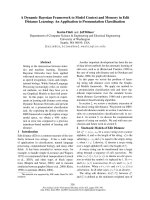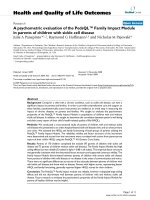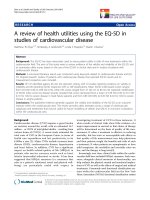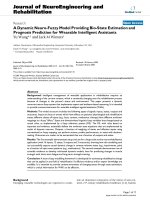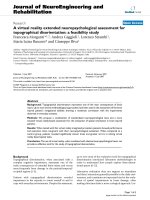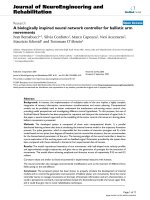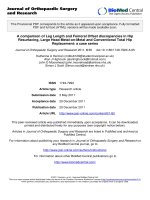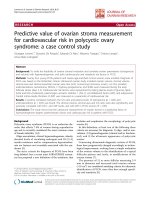Báo cáo hóa học: " A Dynamic Reconfigurable Hardware/Software Architecture for Object Tracking in Video Streams" pptx
Bạn đang xem bản rút gọn của tài liệu. Xem và tải ngay bản đầy đủ của tài liệu tại đây (1.9 MB, 8 trang )
Hindawi Publishing Corporation
EURASIP Journal on Embedded Systems
Volume 2006, Article ID 82564, Pages 1–8
DOI 10.1155/ES/2006/82564
A D ynamic Reconfigurable Hardware/Software Architecture
for Object Tracking in Video Streams
Felix M
¨
uhlbauer and Christophe Bobda
Department of Computer Sciences, University of Kaiserslautern, Gottlieb-Daimler Street 48, 67653 Kaiserslautern, Germany
Received 15 December 2005; Revised 8 June 2006; Accepted 11 June 2006
This paper presents the design and implementation of a feature tracker on an embedded reconfigurable hardware system. Contrary
to other works, the focus here is on the efficient hardware/software partitioning of the feature tracker algorithm, a viable data flow
management, as well as an efficient use of memory and processor features. The implementation is done on a Xilinx Spartan 3
evaluation board and the results provided show the superiority of our implementation compared to the other works.
Copyright © 2006 F. M
¨
uhlbauer and C. Bobda. This is an open access article distributed under the Creative Commons Attribution
License, which permits unrestricted use, distribution, and reproduction in any medium, provided the original work is properly
cited.
1. INTRODUCTION/MOTIVATION
Pervasive and ubiquitous computing is gaining more and
more in popularity. Boosted by advances in broadband com-
munication and processing systems, computer anytime and
anywhere is slowly but surely becoming a reality. Ubiquitous
and pervasive computing usually involve a set of distributed
sensing and computing nodes geographically located at dif-
ferent sites. Each node collects a given amount of raw data
that is exchanged with other nodes in the system. One of the
main requirements here is that raw data collected by sensors
at a given geographic location by a given system or part of
it should be processed by a corresponding module at that
location. Therefore, the communication between different
nodes is reduced. Only the results of computations at differ-
ent sites—which are mostly sensor data interpretation with
a reduced amount compare to the raw data—have to be sent
to other nodes.
The constraints imposed on pervasive and ubiquitous
computing systems—which are mostly untethered—lead
to a very challenging design process. Large amount of
data must be computed in real time whilst at the same
time maintaining a very low power consumption for the
whole system. Furthermore, the system must be able to
adapt to changing environmental and operational condi-
tions. None of the processors commonly used in embed-
ded systems like DSPs, ASICs or general purpose proces-
sors can provide the features alone (performance, low power,
and adaptivity) that are required in ubiquitous and pervasive
systems.
The last decade has experienced an increasing interest
in deployment of FPGAs in embedded systems. With the
progress in manufacturing technology, FPGAs have become
40 times faster a nd consume 50 times less power with an in-
crease of 200 fold in their capacity (number of available logic
cells) whilst at the same time becoming 500 times cheaper
in less than 15 years. According to several studies, this trend
is going to be maintained at least in medium term. It is in-
creasingly possible to implement a complete system on-chip
solution using the lowest cost FPGA device. Furthermore, the
partial reconfiguration capability of FPGAs allows for the re-
alization of adaptivity, thus making FPGAs more and more
attractive for pervasive and ubiquitous systems [1].
A main advantage of these programmable logic devices is
the ability to realize parallel processing hardware. Especially
image processing algorithms are inherently parallel and thus
FPGAs can be used to develope highly efficient solutions. In
many systems, for example, in surveillance systems, video
data is captured by modules and sent to other modules for
further processing. The processing task can be, for example,
the detection of movement or the detection and tracking of
suspect objects in a given environment that is monitored by
a camera.
A system on chip is usually made up of a processor con-
nected to a set of peripherals and dedicated hardware mod-
ules via a bus system. The bus system is mastered by the pro-
cessor to access peripherals and collect data to be processed.
In video streaming applications in which large amount of
data must be computed in real time while st reaming through
different computational blocks, a traditional system on chip
2 EURASIP Journal on Embedded Systems
in which all the data transfer between different modules is
done on the bus is no l onger viable. The exclusive use of the
bus at a given time by one master hinders simultaneous ac-
cess to data by different modules.
In this work, we present a modular implementation of
a feature tracker for video streams in an FPGA. The archi-
tecture is made up of a system on chip in which a processor
and dedicated hardware accelerator modules cohabit. Con-
trary to traditional system on chip, we do not rely only on
a bus for communication. A set of dedicated line and proto-
cols allow for a real-time computation of data while they are
streamed.
The implementation is done on a Xilinx evaluation board
featuring a Spartan 3 FPGA and on a ML310 board with a
Virtex2 Pro.
The remainder of this paper is organized as fol lows.
Section 2 introduces the feature tracking and presents algo-
rithms used. In Section 3, we present an overview of the re-
lated work. Section 4 presents the design of the feature track-
ing system on an FPGA. There we will discuss the main de-
sign decision. The adaptivity of the system is also discussed
in this section. In Section 5 , we present the implementation
results for two platforms. Finally, Section 6 concludes the pa-
per and gives some indication of future work.
2. OBJECT TRACKING IN VIDEO STREAMS
For object tracking purposes often feature trackers are used,
which analyze image sequences and detect motion. For this
purpose small windows, called features, with certain at-
tributes are selected and then attempts are made to find them
in the next frame. Such attributes can, for example, be some
measure of texturedness or cornerness, like a high standard
deviation in the spatial intensity profile, the presence of zero
crossings of the Laplacian of the image, or a simple corner.
Yet, apparently promising features can be useless or even
harmful for tracking, if they do not correspond to a point
in the real world. This happens with h otspots (a reflection of
a highlight on a glossy surface), mirroring, or in the case of
straddling a depth discontinuity. Conversely, useful features
can be lost if they leave the field of vision by obstruction or
by moving out of the image. The well-known KLT-tracker
1
is
often used as a base for further development.
The same case is with the fol l owing algorithm which is
the approach of Shi and Tomasi [4]. According to them, the
pure translation model is not an adequate model for image
motion when measuring dissimilarity between the features.
They provide experimental evidence for this and introduce
an extended model considering affine image changes.
Image motion can be regarded as a change in image in-
tensity I of a given point (x, y)attimet + τ:
I(x, y, t + τ)
= I
x − ξ(x, y, t, τ), y − η(x, y, t, τ), t
. (1)
1
Kanade, Lucas, and Tomasi [2, 3].
The time-dependent functions ξ and η provide the displace-
ment in x and y directions. So, δ
= (ξ, η) defines the amount
of motion and, respectively, the displacement of the point at
x
= (x, y). Even within the small windows used for feature
tracking, δ varies and a certain displacement vector does not
exist. A more efficient way is to consider the affine motion
model:
δ
= Dx + d,(2)
where
D
=
d
xx
d
xy
d
yx
d
yy
(3)
is a deformation matrix and d is the translation of the feature
window’s center. Applying this to the intensity relation leads
to
J(Ax + d)
= I(x), where A = Id + D. (4)
This means that for any two given images I and J six param-
eters must be calculated. The qualit y of the results depends
on the size of the feature window, the texture of the image
within it, and the amount of motion (camera or object) be-
tween frames. Smaller features result in less reliable values for
D, because only few image changes are considered, but are
generally preferable because they are less likely to straddle a
depth discontinuity.
Because of image noise and because the affine motion
modelisnotperfect,(4) is in general not satisfyingly exact
enough. To solve this problem the following equation is used
to reduce the minimal error to a sensible value for A and d:
=
W
J(Ax + d) − I(x)
2
w(x)dx,(5)
where W is the feature window and w(x) a weighting func-
tion, which comes to 1 in the simplest case. Alternatively, a
Gaussian-like function can be used to emphasize the center
area of the window.
Theproblemcanbeconvertedtoalinear6
× 6system
and D and d can be found with an iterative Newton-Raphson
style minimization (see [ 5]).
Shi and Tomasi use the pure translation model for track-
ing and affine motion for comparing features between the
first and the current frames in order to monitor quality.
This algorithm has its advantages and drawbacks. First, it
works at subpixel precision. Feature windows in frames will
never be identical because of image noise, intensity changes,
and other interfering factors. Thus translation estimation
cannot be absolutely accurate, the errors accumulate and fea-
ture windows drift from their actual positions. In [6] Zinßer
et al. take care of this problem and also deal with illumina-
tion compensation. Another advantage of their concept is the
detection of distorted and rotated features, which is achieved
by the affine motion model.
F. M
¨
uhlbauer and C. Bobda 3
The algorithm excessively uses floating point operations
causing high resource costs. Also, only small translations
can be estimated which requires slow moving objects in the
observed scene or high frame rates of the incoming video
stream, which results in high resource consumption, too. We
want to introduce another procedure for tracking features
which is much more suitable for an implementation on FP-
GAs.
The following algorithm refers to [7]. In contrast to the
KLT-tracker, features (in this case: Harris corners
2
)arede-
tected in each frame and only comparisons between features
are permitted. For that purpose each position in the current
frame, or to be more precise a feature window with this posi-
tion (feature point) in the middle, is assessed: the derivatives
I
x
and I
y
are computed by horizontal and vertical filters in the
form
−
101
. Next, the products I
x
I
x
, I
x
I
y
and I
y
I
y
are
separately convolved with the binomial filter
14641
,
again horizontally and vertically, to produce the values G
xx
,
G
xy
,andG
yy
. Now determinant d = G
xx
G
yy
−G
xy
2
,tracet =
G
xx
+ G
yy
, and finally the strength s = d − kt
2
with k = 0.06
of the corner response are calculated (see Figure 1(a), white
areas represent high values of s).
To define the actual feature points, nonmax suppression
is used: each pixel for which the corner response is strongest,
considering a 5
×5 neighborhood, is declared a feature point.
This method is an alternative to using a global threshold for
the strength of the corner response (see Figure 1(b), where
features are marked).
For matching, each feature is compared with all features
of the next frame which reside within a certain distance of
the original window. To achieve this, normalized correlation
is used. The distance can be adjusted to performance require-
ments. Because Harris corners happen to be in the corner
of their feature window, which impedes correct matching, a
bigger window of 11
× 11 pixels (n = 121) is used instead.
Manycomparisonshavetobemadebutfortunatelysome
values can be precomputed:
A
=
I,
B
=
I
2
,
C
=
1
√
nB − A
2
.
(6)
With the scalar product
D
=
I
1
I
2
(7)
of the two features to be compared, the normalized correla-
tion is
=
nD − A
1
A
2
C
1
C
2
. (8)
2
The Harris corner detector computes the locally averaged moment matrix
computed from the image gradients, and then combines the eigenvalues
of the moment matrix to compute a corner strength, of which maximum
values indicate the corner positions.
To decide which matches to accept, a mutual consistency
check is used: all features are compared under several dif-
ferent aspects. For each feature, the preferred counter part,
which produces the highest value of
, is saved. Finally only
features w hich mutually fit each other are valid matches.
This algorithm is not equipped with a drift detection. In
addition, because of the irregular input data, as mentioned
above, the features, which are detected for every frame, will
vary and matching is partly impeded. On the other hand,
translations over larger distances can be estimated while only
low frame rates are needed and calculations are simple, com-
pared to the first algorithm which excessively uses floating
point operations. Further, the complete feature detection and
selection process is highly parallelizable and additionally can
be computed using integer operations only. These are very
good preconditions for hardware/software co-design imple-
mentation on an FPGA.
3. RELATED WORK
Feature tr acking is usually implemented in the context of au-
tonomous navigation where objects have been detected and
tracked by a given entity. Most of the available systems are
implemented as a pure software solution [4–7]. Usually a
personal computer is mounted on a robot to perform the re-
quired computation. Acceleration of feature tracking on par-
allel computers is considered in [8–10]. The MIMD is con-
sidered in [9] while [10] implements the SIMD paradigm.
The target platform for the MIMD implementation is a Mas-
Par MP-1 with a 128
×128 mesh of processing elements while
the SIMD targets the Intel Paragon and the IBM SP2 plat-
forms. The implementation of [8] is used more often for sim-
ulation purposes and is done on an adaptive grid machine
called GrACE.
While such solutions can be useful for experimental pur-
poses and for proof of concept, it is not applicable to real
autonomous systems. Parallel machines, for example, can-
notbeusedinanembeddedenvironmentbecausethepower
consumption of workstations mounted on a robot will allow
the robot only to drive a few meters. Moreover, the size of the
robotmustbesufficiently large to carry the PC, thus leading
to a very large system.
Some effort to tackle the aforementioned problem has
been done in [11–13]. In [12] the goal is to have a real-time
implementation of the feature tracking using a hardware
platform. The target system is a C4x board featuring eight
Texas instrument processors C4x running at 50 MHz. Each
processor is assig ned a specific task. One processor grabs
the frame, two processors perform feature selection, and one
processor performs motion estimation. Feature tracking is
done by three processors and the rendering is done by one
processor. The system is able to process 0.8framespersecond
for feature detection (100 features) and 4 frames per second
for feature tracking, leading to an overall performance of 0.8
frames per second. Although the size of this system as well
as its power consumption remains low compared to a soft-
ware solution, it is still far from being suitable to be used in a
mobile system.
4 EURASIP Journal on Embedded Systems
(a) (b)
Figure 1: Feature detection and selection.
Some recent works [11, 13] have targeted FPGAs for an
efficient implementation of feature t racking. In [11]features
are selected in an FPGA mounted on a PCI-Board, which is
embedded in a workstation. Not only cannot this solution
be used in small mobile environments, it also presents the
drawback that the processor, a 3 GHz Pentium, must be used
all the time for data transfer between the FPGA and the pro-
cessor.
The system in [13] is a more compact hardware/software
system. The software part is implemented on a PowerPC pro-
cessor that is attached to an FPGA in which the hardware
part is implemented. The FPGA is in charge of the image en-
hancement that is done using a high pass filtering process.
The implementation uses a sliding window that is used to
capture the neighborhood of an incoming pixel. The latter is
then used to compute the enhanced value of the pixel that is
stored in a memory shared by the PowerPC and the FPGA.
The adaptive process is done via the modification of the filter
parameters as well as the threshold parameter for the number
of features to be selected. Because the single available mem-
ory can be accessed only by one module (processor or FPGA)
at a time, the streaming computation process will be delayed
leading to a decrease in the number of frames that may be
processed in a second. The FPGA is used in this system as an
ASIC, since no reconfiguration is done. Because the struc-
ture of filters varies according to the algorithms used, a sim-
ple change in the filter coefficient is not sufficient to replace a
filter in the FPGA. The Sobel operator, for example, is two di-
mensional while the Laplace is only one dimensional. There-
fore, a Laplace filter cannot become a Sobel just by replacing
the coefficients. The configuration of the FPGA can be used
to replace the complete filter structure.
This work presents a better use of a single chip to imple-
ment an embedded adaptive hardware/software solution to
feature tracking. The system is optimized to perform com-
putations on all the streamed frames without delay. We also
exploit the possibilities to dynamically extend the instruction
set of the embedded processor by binding an accelerator di-
rectly to the processor. Adaptivity is done by means of con-
figuration rather than by parameter modifications as is the
case in [13].
4. DESIGN OF A HARDWARE/SOFTWARE
SOLUTION FOR FPGA
This section describes our implementation of the chosen fea-
ture tracking algorithm. The data flow from the incoming
images to the positions of image movements looks like this:
video in
→ feature detection → feature selection → feature
tracking
→ further processing.
The feature detection is highly parallelizable and can be
implemented completely in hardware (see Figure 2). A com-
pilation of five convolve filters (for I
x
, I
y
, G
xx
, G
xy
,andG
yy
)
and simple arithmetic operations is used. Usually convolving
is realized using a sliding w indow, whose size can b e 3
× 3,
5
× 5, and so on. In case of a 3 × 3 window, incoming pixel
data must fill up two line buffers before the first calculation is
possible. The latency results in 2 lines +2pixels +1clockcy-
cles. The corner strength can be computed by add, subtract,
and multiply units. Down shifting provisional results prevent
arithmetical overflows. The fac tor k
= 0.06 in s = d − kt
2
can be approximated by shifting by 4 ( =k = 0.0625). The
FPGA used is equipped with single clock cycle multipliers.
Thus, the corner strength calculation needs only three fur-
ther clock cycles to be completely computed while using only
integer numbers.
For feature selection nonmax suppression is used, which
is realized by a sliding window, too. Each value within the
F. M
¨
uhlbauer and C. Bobda 5
I
3
3convolve
I
x
I
y
Mul Mul Mul
I
xx
I
xy
I
yy
1 5 binomial 1 5 binomial 1 5 binomial
5
1 binomial 5 1 binomial 5 1 binomial
G
xx
G
xy
G
yy
Mul Mul Add
Sub
Mul
>>
Sub
s
5
5max
Figure 2: Logic for feature detection.
window is compared with the center value. If it is the maxi-
mum the window position is declared a feature point.
For a system on-chip layout, these preliminary ideas al-
low a hardware/software partitioning as shown in Figure
3(a). T he feature detection and selection is completely im-
plemented in a dedicated hardware module (FT) and feature
tracking is done in software by the Xilinx MicroBlaze pro-
cessor. The video frames are captured by the videoin module
and stored in the SRAM. The RS232 module is used for de-
bugging purposes.
Considering the data transfer, there is communication
between video input module and feature module, between
feature module and memory in order to access the current
frame and store the selected features, and between processor
and memory in order to continue with tracking these fea-
tures. All transactions simultaneously utilize the bus, which
is in general only designed for low peripheral load. The
amount of data produced by video streams is very high and
clutters up the bus. That means that this solution is not fit to
process data in real time.
4.1. Efficient hardware/software partitioning
By rearranging the components w hile accounting for the
data flow, performance can be improved. Our architecture
is shown in Figure 3(b). The videoin module sends image se-
quences to the feature module, which stores image data and
selected features in the memory. A dual ported memory is
used that can be accessed from two different clients and clock
domains. The feature module is, furthermore, connected to
the bus to exchange information with the processor. This in-
formation consists of controlling instructions like “start” and
“stop,” but also of parameters like the base address of image
data in the memory or parameters which influence the pro-
cessing. The BlockRAM is the main memory of the proces-
sor and holds data like variables and heap of the application
running on it. A certain area of the memory is reserved for
image and feature data by the application. To notify the fea-
ture module about the location of this area the base address
is transmitted by the processor to the module over the bus.
4.2. Dynamic reconfiguration increases flexibility
The Xilinx FPGAs allow partial reconfiguration of each in-
dividual column. The Erlangen slot machine (ESM) [14]is
an architecture that exploits this feature. Its new concept al-
lows an unrestricted relocation of modules on the device.
The FPGA is logically divided into slots which can be repro-
grammed independently. Via a programmable crossbar each
module can, regardless of placement, communicate with its
peripherals and also with other modules. Memory banks are
vertically attached to each slot, providing enough memory
space to store temporary data. In streaming applications, this
memory can also be used for shared memory communi-
cation between neighboring modules. Smaller data chunks
can be transferred either by placing (dual ported) Block-
RAM between them or via a reconfigurable multiple bus
(RMB).
Figure 4 shows the possible placement of our feature
tracker on the ESM platform. The data flow was already de-
scribed above. Using multiple memory banks, a technique
called double buffering can further increase performance:
image frames are filled alternately into two banks by the
videoin module. The feature module reads out data but al-
ways from the respectively other bank. Hence, in contrast to
a single memory architecture, no bottleneck will occur while
accessing the memory.
Reconfiguration highly increases flexibility of the feature
tracker. This means that, for example, the source of incom-
ing image stream can simply be an analog video input as well
as a firewire or LAN connection. By reconfiguration the in-
put module can be replaced by an appropriate one. Image
prefiltering, like illumination compensation or the Gaussian
function to smooth image noise, increases the quality of the
tracking results. In addition, feature detection and selection
processes can be altered or exchanged to adapt to the sys-
tem environment. The tracker unit can use dedicated helper
hardware, fore example, to speed up the comparison of fea-
tures (see next subsection). In contrast to works like [13]we
6 EURASIP Journal on Embedded Systems
MicroBlaze
Dual ported
BlockRAM
Code Data
OPB
SRAM LAN
Video in RS232 FT
Periphery
OPB
= on-chip periphery bus
FT
= feature detection and selection
(a) Suboptimal system on chip
MicroBlaze
BlockRAM
Code Data
OPB
SRAM
Dual ported
BlockRAM
FT
Video in
OPB
= on-chip periphery bus
FT
= feature detection and selection
(b) Efficient hardware/software partitioning
Figure 3: System architecture.
RAM RAM RAM
Video in
FT
MicroBlaze
Figure 4: Mapping of the feature tracker on the column-based re-
configarable device.
rely on reconfiguration rather than on just exchanging mod-
ule parameters to increase flexibility.
4.3. Instruction set metamorphosis
By analyzing the remaining part of the algorithm, namely,
feature tracking, which is done in software, some more im-
provements are possible. The features of the MicroBlaze pro-
cessor can be upgraded. Eight fast communication chan-
nels, called fast simplex links (FSL), are available to connect
dedicated hardware accelerators, which are linked through
FIFO buffers. The instruction set offers special put and gets
Put
FIFO
MicroBlaze
FIFO
Get
Custom HW
accelerator
Figure 5: Instruction set extension through fast simplex link.
commands to access these pipelines by software (shown in
Figure 5).
The tracking code reads each image point from the mem-
ory to calculate the parameters for the normalized correla-
tion (8). A software implementation only allows a sequen-
tial computation of each individual pixel. We take advantage
of the FSL and the dedicated hardware attached to it to in-
crease the throughput as well as the speed of feature compar-
ison. Since one pixel is represented by 8 bits and the FSL and
memory bus width are both 32 bits, we are able to transfer
and process four pixels at once. The hardware accelerator si-
multaneously calculates the sum A and the sum of squares B
while the processor only pushs data into the FIFO. A similar
procedure is used to compute scalar products D while feature
comparison phase.
5. RESULTS
Our design was implemented on a Spartan 3 (xc3s400)
FPGA. This FPGA is to small to host all hardware acceler-
ators together with the microBlaze processor. Thus our first
implementation is a software only version which runs com-
pletely on the microBlaze.
F. M
¨
uhlbauer and C. Bobda 7
Table 1: Performance of software only solution.
Spartan 3 board ML310 board (Virtex2 Pro)
Feature detection 5.01 s 153 ms
Feature selection (30 features) 0.89 s 78 ms
Tracking 1.6s 28ms
Table 2: Pipeline stages for hardware feature detection and selection and their latencies. Examples with different image formats and system
clocks.
Stage Logic Purpose Latency
13× 3convolve I
x
and I
y
2l +2+1
2 3 multipliers I
∗
products 1
31
× 5 convolve Binomial horiz. 4 + 1
45
× 1 convolve Binomial vert. 4l +1+1
5 Arithmetic d, t, s 3
65
× 5 convolve Feature selection 4l +4+1
Total 10l +19
QCIF (176 × 144 pixels), 50 MHz 35.58 μs
QCIF (176
× 144 pixels), 100 MHz 17.79 μs
VGA (640
× 480 pixels), 100 MHz 64.19 μs
MicroBlaze
I/D LMB
SRAM
OPB
Debug
FIFO
(mb to filter)
FT
VGA
FIFO
(filter to mb)
Figure 6: Floorplan of the feature tracker on a Xilinx Spartan 3
FPGA.
Figure 6 shows the placement of the modules in the floor-
planner tool. The resulting design in its placed and routed
form can be seen in Figure 7.
Considering the timings of a software only solution
(which takes no advantage of hardware accelerators) feature
detection takes 5.01 s executed on the introduced design. The
latency for feature selection is proportional to the amount
of features found, for example, the latency for 80 features
is 2.39 s. As we will see in the following this is much slower
than the hardware solution. The tracking part takes 1.6sper
frame.
Porting to a Xilinx ML310 board equipped with a Vir-
tex2 Pro FPGA and using a newer version of the development
MicroBlaze
I/D LMB
SRAM
OPB
Debug
FIFO
(mb to filter)
FT
VGA
FIFO
(filter to mb)
Figure 7: Placed and routed design of the feature tracker.
tools further increased the performance and allowed timings
in the range of milliseconds (see Ta ble 1).
Table 2 summarizes the pipeline stages of the hardware
feature detection and selection module (independent from
the complete design) and their latencies. The underlying al-
gorithm was already described in Section 2 so only some re-
marks follow: Stage 2 computes the values I
x
I
x
, I
x
I
y
,andI
y
I
y
and stage 3 and 4 produce the values G
xx
, G
xy
,andG
yy
.
Stage 5 uses arithmetic units to calculate the corner response
strength s. Final ly stage 6 selects features using a modified
convolve filter. The total latency results in 10l + 19 clock cy-
cles, where l is the image width. The table also shows exam-
ples for different image formats and system clocks.
8 EURASIP Journal on Embedded Systems
Because this design processes one pixel per clock, very
high frame rates are achieved. The frame rate can be cal-
culated as system clock divided by image size, for example,
1972 fps for a QCIF format or 162 fps for a VGA (640
× 480
pixels) resolution. Of course the tracking part that runs in
software on the MicroBlaze cannot achieve this high perfor-
mance and thus is the bottleneck in this case. The tracking
delay of 28 ms allows about 3-4 frames per second with a
video stream in QCIF format.
6. CONCLUSIONS
In this paper, we have designed and implemented an effi-
cient and flexible feature tracker on a reconfigurable device.
The efficiency is obtained by using a viable hardware/soft-
ware partitioning, by communication between modules, as
well as by using an efficient memory access. Furthermore,
the exploitation of the MicroBlaze features, like the fast sim-
plex link, improves the performance further. Contrary to
other works that modify the parameters of some filter to in-
crease flexibility, we use reconfiguration to exchange hard-
ware modules with different structures. The progress made
in the last decade have affected the power consumption and
the size of FPGAs, their costs have dropped rapidly while
their capacity continues to increase. This trend is expected to
continue, allowing the use of FPGAs in mobile autonomous
environments. Our future work is to further improve the
tracking part of our solution and the deployment in a system
of cooperative intelligent robots using FPGAs as computing
platform.
REFERENCES
[1] P. Lysaght, “FPGAs in the decade after the von Neumann cen-
tury,” in Friday workshop at Design, Automation and Test Euro-
pean (DATE ’06), Munich, Germany, March 2006.
[2] B. D. Lucas and T. Kanade, “An iterative image registration
technique with an application to stereo vision,” in Proceed-
ings of the 7th International Joint Conference on Artificial Intel-
ligence (IJCAI ’81) , pp. 674–679, Vancouver, BC, Canada, Au-
gust 1981.
[3] C. Tomasi and T. Kanade, “Detection and tracking of point
features,” Tech. Rep. CMUCS-91-131, Carnegie Mellon Uni-
versity, Pittsburgh, Pa, USA, 1991.
[4] J. Shi and C. Tomasi, “Good features to track,” in Proceedings of
the IEEE Computer Society Conference on Computer Vision and
Pattern Recognition (CVPR ’94), pp. 593–600, Seattle, Wash,
USA, June 1994.
[5] J. Shi and C. Tomasi, “Good features to track,” Tech. Rep. TR-
93-1399, Department of Computer Science, Cornell Univer-
sity, Ithaca, NY, USA, 1993.
[6] T. Zinßer, C. Gr
¨
aßl, and H. Niemann, “Efficient feature
tracking for long video sequences,” in Proceedings of the
26th DAGM Symposium, pp. 326–333, T
¨
ubingen, Germany,
August-September 2004.
[7] D. Nister, O. Naroditsky, and J. Bergen, “Visual odometry,”
Tech. Rep. CN5300, Sarnoff Corporation, Princeton, NJ, USA,
2004.
[8] J. Chen, D. Silver, and M. Parashar, “Real time feature extrac-
tion and tracking in a computational steering environment,”
in Proceedings of the High Performance Computing Symposium
(HPC ’03), pp. 155–160, Society for Modeling and Simulation
International, San Diego, Calif, USA, March-April 2003.
[9] M. B. Kulaczewski and H. J. Siegel, “Implementations of a
feature-based visual tracking algorithm on two MIMD ma-
chines,” in Proceedings of the International Conference on Par-
allel Processing, pp. 422–430, Bloomington, Ill, USA, August
1997.
[10] M. B. Kulaczewski and H. J. Siegel, “SIMD and mixed-
mode implementations of a visual tracking algorithm,” in
Proceedings of the International Parallel Processing Symposium
(IPPS/SPDP ’98), pp. 716–720, Orlando, Fla, USA, March-
April 1998.
[11] A. Bissacco, J. Meltzer, S. Ghiasi, S. Soatto, and M. Sarrafzadeh,
“Fast visual feature selection and tracking in a hybrid recon-
figurable architecture,” Tech. Rep., UCLA, Los Angeles, Calif,
USA, 2004. />∼bissacco/hybridfeatrack.
html.
[12] X. Feng and P. Perona, “Real time motion detection system and
scene segmentation,” Tech. Rep. CIT-CDS-98-004, California
Institute of Technology, Pasadena, Calif, USA, 1998.
[13] S. Ghiasi, A. Nahapetian, H. J. Moon, and M. Sarrafzadeh,
“Reconfiguration in network of embedded systems: challenges
and adaptive tracking case study,” Journal of Embedded Com-
puting, vol. 1, no. 1, pp. 147–166, 2005.
[14] C. Bobda, M. Majer, A. Ahmadinia, et al., “The erlangen
slot machine: a highly flexible fpga-based reconfigurable plat-
form,” in Proceedings of the 13th Annual IEEE Symposium
on Field-Programmable Custom Computing Machines (FCCM
’05), pp. 319–320, Napa, Calif, USA, April 2005.
Felix M
¨
uhlbauer completed his degree in
the diploma course of studies in com-
puter science at the University of Erlangen-
Nuremberg, in 2005. Since November 2005
he works as a Scientific Assistant in the Self-
Organizing Embedded Systems group in the
Department of Computer Sciences at the
University of Kaiserslautern .
Christophe Bobda is the leader of the new
created working group “Self-Organizing
Embedded Systems” in the Department
of Computer Sciences at the University
of Kaiserslautern. He received the Licence
in Mathematics from the University of
Yaounde, Cameroon, in 1992, the diploma
of computer science and the Ph.D. degree
(with honors) in computer science from
the University of Paderborn in Germany,
in 1999 and 2003, respectively. In June 2003, he joined the De-
partment of Computer Science at the University of Erlangen-
Nuremberg in Germany as a Postdoctoral. He received the Best Dis-
sertation Award 2003 from the University of Paderborn for his work
on synthesis of reconfigurable systems using temporal partitioning
and temporal placement. He is a Member of the IEEE Computer
Society, the ACM, and the GI. He is also in the program commit-
tee of several conferences (FPT, RAW, RSP, ERSA, DRS), the DATE
executive committee as proceedings chair (2004, 2005, 2006). He
served as a Reviewer of several journals (IEEE TC; IEEE TVLSI;
Elsevier Journal of Microprocessor and Microsystems; Integration,
the VLSI Journal) and conferences (DAC, DATE, FPL, FPT, SBCCI,
RAW, RSP, ERSA).
